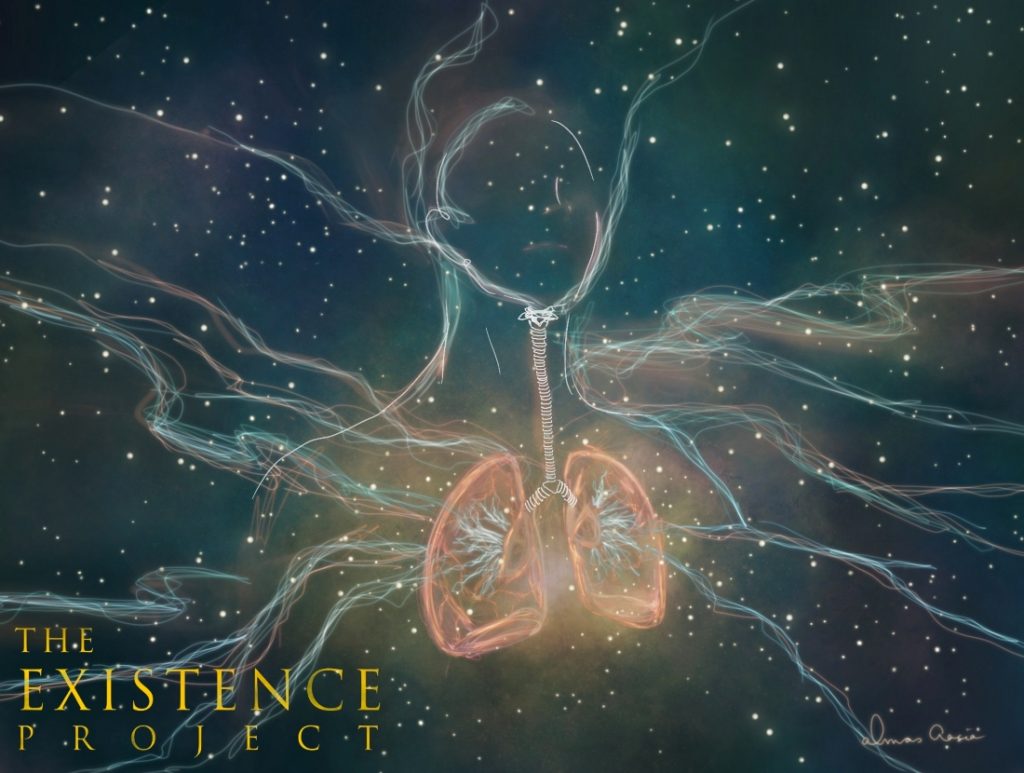
(Artist: Almas Aasia)
Faizan Ahmed, USA
Inhale. Exhale. A single breath—so simple, yet so profound. In the time it takes to draw in air and release it, an extraordinary sequence of events unfolds within our bodies. From the moment air enters our nostrils to the instant carbon dioxide is expelled, the complexity and precision of this process defy the possibility of mere chance. The act of breathing is not merely functional; it is a symphony of life that operates with flawless timing and purpose.
The Journey of One Breath: A Symphony of Precision
The journey begins as air enters the nostrils, where it is filtered, humidified, and warmed to body temperature. Without this initial conditioning, cold or contaminated air would reach the lungs, damaging delicate tissues. The air then travels down the trachea, splitting into two primary bronchi—one for each lung. But this is just the beginning. These bronchi branch into over 30,000 smaller bronchioles, resembling the branches of a vast tree.1 This intricate network ensures that every single alveolus receives fresh air, maximizing the efficiency of gas exchange.
As air continues its journey, it reaches the alveoli—tiny air sacs numbering about 600 million, each with walls only one cell thick. Here, the design reaches its zenith: the surface area of these alveoli is roughly 70 square meters, about the size of a tennis court, ingeniously packed within the confines of our lungs.2 This vast surface area facilitates rapid gas exchange, allowing oxygen to diffuse effortlessly into the bloodstream while simultaneously expelling carbon dioxide.
If these alveoli did not function with such precision, the consequences would be catastrophic. Without the vast surface area and delicate membrane, oxygen would not efficiently enter the bloodstream, leading to respiratory distress, organ failure, and ultimately, death within minutes. This is why diseases like emphysema, a pathology that results in damage to the air-filled sacs are so deadly—they compromise the design of this life-giving system; however, the human body is not entirely defenseless. It is equipped with backup mechanisms that ensure the lungs can continue to function even when disruptions occur. One such mechanism is alveolar recruitment, where the lungs compensate for underutilized or collapsed alveoli—whether due to illness, shallow breathing, or temporary blockage—by recruiting additional alveoli to maintain optimal oxygen exchange. This “reserve capacity” ensures that oxygen levels in the blood remain stable, even when part of the lung is compromised. Another crucial mechanism is hypoxic pulmonary vasoconstriction (HPV), which redirects blood flow away from poorly ventilated regions of the lung to healthier, better-ventilated areas. This response prevents the circulation of deoxygenated blood and ensures that oxygen delivery to the body remains as efficient as possible. These built-in compensatory systems highlight the remarkable adaptability of the respiratory system, further underscoring the flawless design required to sustain life.
To appreciate the complexity further, consider this: the diffusion distance between the alveolar air and blood is less than the width of a human hair. This microscopic precision ensures that oxygen binds efficiently to hemoglobin, the carrier within red blood cells. This binding is not random; it is exquisitely regulated by pH and temperature, optimizing oxygen delivery to tissues precisely when and where it is needed. If this delicate balance were disrupted—even slightly—cells would be deprived of oxygen, leading to organ failure within minutes.
All of this happens in just one breath. In less than five seconds, air travels through a labyrinth of passages, interacts with an astonishing surface area, and engages in a delicate chemical dance, all orchestrated with flawless timing and precision. If even one step were altered, the entire system would collapse. Could such complexity truly be the product of random chance?
Critics of intelligent design often argue that if humans were truly designed perfectly, we would not rely on a seemingly vulnerable shared airway for both breathing and eating. They question why the airway’s sole protection against choking is the epiglottis, which appears at first glance to be just a fragile flap of tissue that covers the opening to the lungs every time we swallow. However, the epiglottis is far from a mere flap of tissue—it is a sophisticated, nerve-innervated structure that moves precisely and reflexively over 500 times every day, swiftly sealing off our airway each time we swallow. This remarkable reliability prevents choking in nearly every instance, a testament to its intelligent and precise design.
Furthermore, the epiglottis plays an indirect but crucial role in enabling human speech by protecting and supporting the larynx (voice box) during phonation. When we speak, air from the lungs is pushed upward through the trachea and into the larynx, where the vocal cords (also called vocal folds) vibrate to produce sound. The epiglottis, situated above the larynx, modulates airflow and acts as a barrier that directs air toward the vocal cords during exhalation, facilitating the production of clear, resonant speech. In addition to preventing aspiration during swallowing, the epiglottis provides structural support by maintaining the integrity of the laryngeal framework, ensuring that the vocal cords remain in the optimal position for sound production.
Without this intricate positioning and protective function, the vocal cords would be far more vulnerable to injury and misalignment, compromising the ability to produce articulate speech. Moreover, if the airway and digestive tract were completely separate, this delicate system of sound modulation would be disrupted, preventing the fine-tuned balance required for speech production. Thus, what critics perceive as a flaw is, upon closer examination, a remarkably balanced and purposeful design integral to our very capacity for language and human interaction.
A Masterpiece of Intelligent Design
As an anesthesiology resident who deals with lung physiology daily, I am constantly reminded of the perfection required for every breath. From the chemistry of the air before it even enters our lungs to the precise exchange of gases at the alveolar level, the orchestration of this process is overwhelming proof of intelligent design. One mistake in this sequence—whether in warming the air, branching through the bronchioles, or gas exchange in the alveoli—would mean death within minutes. And this is just one organ system.
The human body relies on oxygen for every cellular function, and that oxygen starts with a single breath. Yet, this doesn’t even touch the complexity of other systems—the heart that pumps this oxygenated blood, the brain that regulates breathing, or the kidneys that maintain blood pH. Each system is interconnected, depending on the other to function seamlessly.
Such perfection cannot be the result of random chance. It points to a design so precise that it defies coincidence. Just as a symphony requires a composer and a masterpiece requires an artist, the human body—starting with a single breath—necessitates an intelligent designer.
In the words of the His Holiness Hazrat Mirza Bashiruddin Mahmud Ahmad (ra), the Second Caliph of the Ahmadiyya Muslim Community, “How can such a perfect order and design result from chaos? Such a vast, intricate system cannot come into existence without a Supreme, All-Powerful Being Who is the Knower of the Unseen.” 4
About the author: Faizan Ahmed is Anaesthesiology Resident with an interest in Critical Care at the University of Louisville, Kentucky, USA. He is also a volunteer with The Existence Project.
References:
- Sapoval B, Filoche M. Optimisations and evolution of the mammalian respiratory system : A suggestion of possible gene sharing in evolution. Eur Phys J E Soft Matter. 2013 Sep;36(9):105. doi: 10.1140/epje/i2013-13105-1. Epub 2013 Sep 26. PMID: 24072464.
- Hsia CC, Hyde DM, Ochs M, Weibel ER; ATS/ERS Joint Task Force on Quantitative Assessment of Lung Structure. An official research policy statement of the American Thoracic Society/European Respiratory Society: standards for quantitative assessment of lung structure. Am J Respir Crit Care Med. 2010 Feb 15;181(4):394-418. doi: 10.1164/rccm.200809-1522ST. PMID: 20130146; PMCID: PMC5455840.
- Amis TC, O’Neill N, Somma ED, Wheatley JR. Epiglottic movements during breathing in humans. J Physiol. 1998 Oct 1;512 ( Pt 1)(Pt 1):307-14. doi: 10.1111/j.1469-7793.1998.307bf.x. PMID: 9729637; PMCID: PMC2231173.
- Hasti Bari Ta‘ala, Hazrat Musleh Mau‘ud (ra), Anwarul Ulum, volume 6, page 301




Add Comment